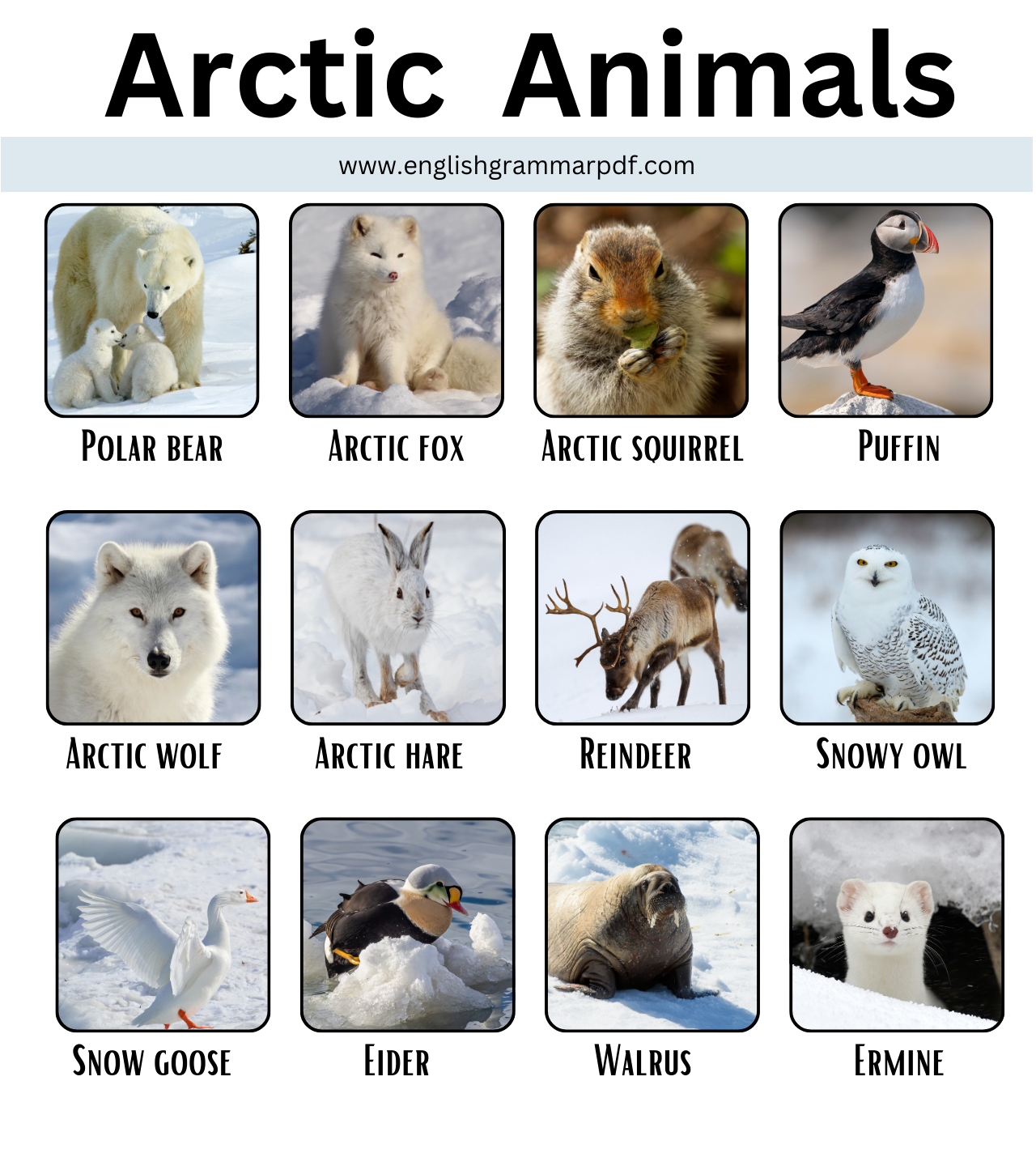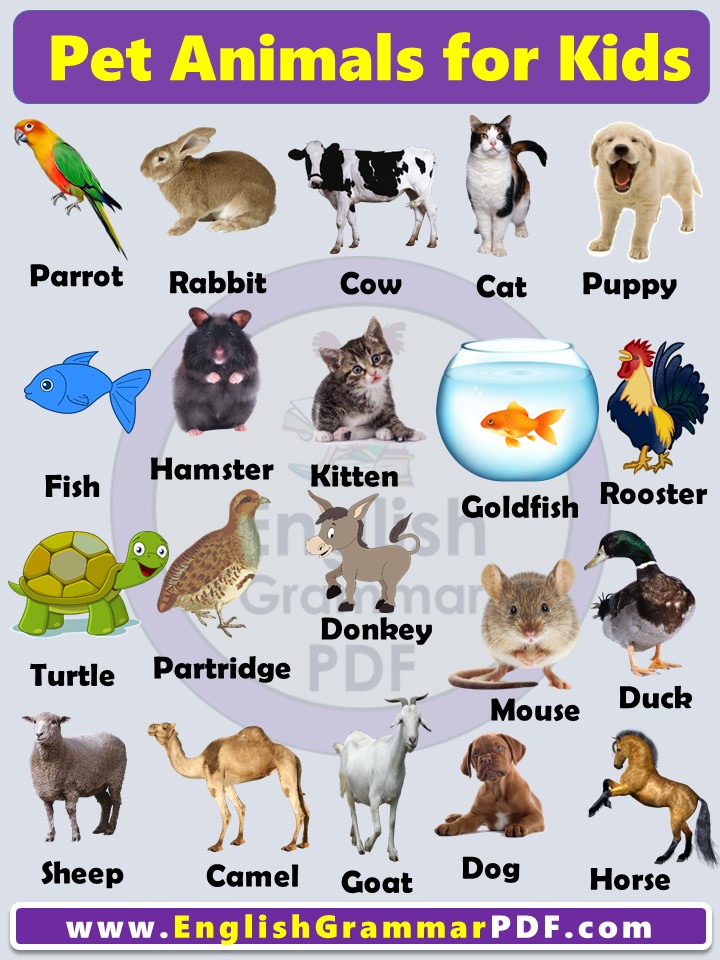Imagine a land of ice and snow, where the sun barely rises in winter, and the night sky is filled with dancing lights. This magical place is the Arctic, home to some of the most amazing animals you’ve ever seen! From the mighty polar bear to the clever Arctic fox, and from the graceful beluga whale to the mysterious narwhal, the Arctic is full of surprises.
Are you ready to embark on an icy adventure to learn about 70 incredible Arctic animals? Get your warmest coat, and let’s dive into a world where the snow never melts and the animals have some cool tricks to survive.
Arctic Animals Names
- Polar Bear: Largest land carnivore, expert swimmer, relies on sea ice.
- Arctic Fox: Small, adaptable, changes fur color with seasons for camouflage.
- Walrus: Large, tusked marine mammal, that forms large social herds on ice.
- Beluga Whale: Small, white whale, known for its vocal communication sounds.
- Narwhal: “Unicorn of the sea” with a long, spiral tusk.
- Snowy Owl: Majestic white owl, excellent hunter, adapted to cold climates.
- Arctic Hare: Large, fast-moving hare, that turns white in winter for camouflage.
- Caribou (Reindeer): Migratory herds, crucial for indigenous peoples, impressive antlers.
- Arctic Tern: Longest migration, flying from the Arctic to the Antarctic and back.
- Musk Ox: Shaggy coat, lives in herds, known for defensive circles.
- Puffin: Colorful beak, excellent swimmer, nests in cliffside colonies.
- Seal: Aquatic, feeds on fish and invertebrates, vital prey for predators.
- Lemming: Small rodent, famous for population booms and busts, key prey.
- Snow Goose: Migratory bird, that travels in large flocks, with distinctive white plumage.
- Arctic Wolf: Lives in packs, adapted to the polar environment, hunts large prey.
- Svalbard Reindeer: Smallest subspecies of reindeer, found in Svalbard, stocky build.
- Ivory Gull: Predominantly white, scavenges polar bear kills, lives near sea ice.
- Ptarmigan: Bird that changes color with seasons, well-adapted to cold.
- Bowhead Whale: Thick blubber, known for its large mouth and long lifespan.
- Ringed Seal: Common Arctic seal, creates breathing holes in sea ice.
- Bearded Seal: Named for its whiskers, large, prefers to pack ice regions.
- Harbor Seal: Found in Arctic and sub-Arctic waters, less ice-dependent.
- Harp Seal: Distinguished by its harp-shaped markings, breeds on pack ice.
- Killer Whale (Orca): Apex predator, found in Arctic marine ecosystems, highly social.
- Arctic Ground Squirrel: Hibernates, and survives extreme temperatures by supercooling its body.
- Ermine (Stoat): Small predator, turns white in winter, except for the black-tipped tail.
- Aleutian Cackling Goose: Small goose, nests on islands, migratory.
- Atlantic Puffin: Known for its colorful beak, excellent diver, and nests in burrows.
- Common Eider: Large sea duck, nests in colonies, known for down.
- Greenland Shark: Long-lived, slow-moving, deep-water shark, found in Arctic waters.
- Hooded Seal: Named for the inflatable nasal cavity in males, lives on pack ice.
- King Eider: Striking appearance, large sea duck, breeds in Arctic coasts.
- Little Auk (Dovekie): Small seabird, nests in colonies on cliffs, plankton feeder.
- Northern Fulmar: Glides over waves, closely related to albatrosses, nests on cliffs.
- Ross’s Gull: Pink breast in breeding season, rare, breeds in High Arctic.
- Spectacled Eider: Striking eye patches, nests in small numbers, threatened species.
- Thick-billed Murre: Penguin-like in behavior, excellent diver, nests on steep cliffs.
- Wolverine: Fierce, solitary, known for strength and ability to kill prey larger than itself.
- Gyrfalcon: Largest falcon, preys on large birds, nests on cliff ledges.
- Long-tailed Duck: Known for its elongated tail feathers, dives for food.
- Red-throated Loon: Smallest loon, distinctive red throat patch, breeds in tundra.
- Rock Ptarmigan: Changes color seasonally, well-adapted to blend with the landscape.
- Sabine’s Gull: Small, fork-tailed gull, breeds on Arctic coasts and tundra.
- Snow Bunting: Small, hardy bird, nests in rock crevices, white winter plumage.
- Steller’s Eider: Small sea duck, threatened, known for spectacular breeding plumage.
- Walrus: Large, tusked, social, relies on sea ice for breeding.
- Polar Cod: A key species in the Arctic food web, survives in cold waters.
- Arctic Char: Cold-water fish, related to salmon, highly valued by anglers.
- Blue Whale: Largest animal ever, an occasional visitor to Arctic waters.
- Common Guillemot (Murre): Dives to great depths, nests in dense colonies on cliffs.
- Glacier Bear: Rare blue-grey bear, subspecies of American black bear, elusive.
- Grey Seal: Large, feeds on fish, breeds on shores and ice floes.
- Humpback Whale: Known for spectacular breaching, migrates to the Arctic in summer.
- Ice Worm: Unique invertebrate, that lives on glacial ice, and survives freezing temperatures.
- Minke Whale: Small baleen whale, feeds in polar waters in summer.
- Northern Bottlenose Whale: Deep-diving whale, has bulbous forehead, found in Arctic waters.
- Polar Cod: Crucial in the Arctic marine food web, survives under ice.
- Purple Sandpiper: Hardy shorebird, winters on icy shores, and feeds on invertebrates.
- Red Phalarope: Breeds in tundra, spends winters at sea, unusual sex roles.
- Snow Petrel: Pure white seabird, breeds in the Antarctic, occasional Arctic visitor.
- Spectacled Guillemot: Black and white seabird, distinctive white eye-ring, cliff nester.
- Spotted Seal: Lives in ice-filled waters, and feeds on fish and shellfish.
- Tufted Puffin: Recognizable by tufts, breeds on coastal cliffs, excellent swimmer.
- White-beaked Dolphin: Social, active, often seen in cold North Atlantic waters.
- Yellow-billed Loon: The largest loon, distinguished by its bill, breeds on Arctic lakes.
- Collared Lemming: A small rodent, with a distinctive collar of fur, that changes color in winter.
- Great Grey Owl: Large owl, hunts in twilight, a ghostly presence in forests.
- Snow Leopard: Not Arctic but high mountain dweller, stunningly beautiful, elusive.
- Arctic Lamprey: Jawless fish, parasitic adults, found in northern rivers.
- Northern Hawk Owl: Daytime hunter, resembles a hawk in behavior, lives in boreal forests.
Arctic Animals Names – Picture



